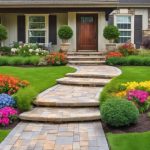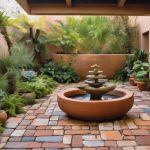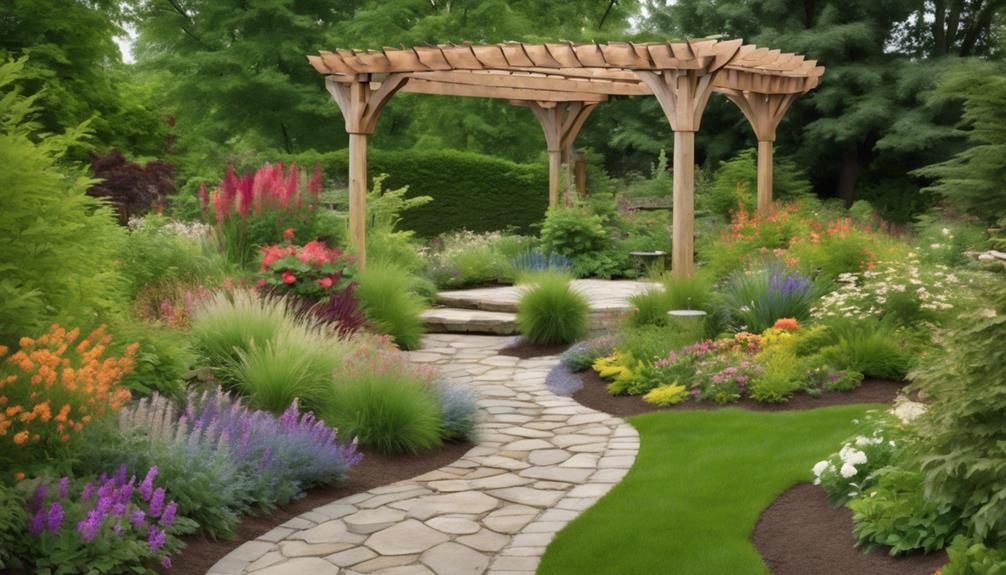
7 Tips to Boost Curb Appeal With Hardscaping
24 October 2024
Top Plants to Enhance Your Hardscaping Design
24 October 2024To enhance your hardscaping features, consider plants that create visual contrast and harmony. Climbing vines can soften vertical elements, while ornamental grasses add texture and movement.
Vibrant flowering plants introduce vivid colours, transforming stark patios into inviting spaces. Selecting native or drought-resistant species promotes sustainability, ensuring your landscape flourishes with minimal care.
Pay attention to the compatibility of plants with hardscaping materials, as this supports aesthetic coherence. Incorporating a variety of plant heights maintains year-round interest.
By exploring strategic plant selections, you pave the way for a more inviting and appealing outdoor environment. Further insights are just ahead.
Enhancing Outdoor Living Spaces
Incorporating plants into hardscaped areas can significantly enhance outdoor living spaces by complementing natural elements and adding depth to the design.
By strategically selecting greenery that contrasts with hard surfaces, homeowners can create a visually appealing environment.
This considered integration fosters a harmonious balance, making outdoor areas more inviting and enjoyable.
Complementing Natural Elements
The interplay between hardscaping and natural elements can transform outdoor living spaces into inviting retreats.
By thoughtfully integrating plants that harmonise with the structural features of your hardscaping, you can create a cohesive aesthetic that enhances the overall environment. Selecting native or drought-resistant species not only complements stone, wood, and metal elements but also promotes sustainability.
Consider using climbing vines to soften vertical surfaces or ornamental grasses to add texture and movement. Furthermore, strategically placed flowering plants can infuse vibrant colour, drawing the eye through the space and creating focal points.
Ultimately, the careful selection and placement of vegetation can elevate the design, fostering a serene atmosphere that encourages relaxation and engagement with nature.
Creating Visual Contrast
To create an engaging outdoor living space, designers often turn to visual contrast as a powerful tool. By juxtaposing different textures, colours, and forms, they can highlight hardscaping features while adding depth and intrigue.
For instance, vibrant flowering plants can enliven the starkness of stone patios, whilst lush foliage can soften the edges of retaining walls. Incorporating plants with varied heights creates vertical interest, drawing the eye upwards and improving spatial dynamics.
Moreover, utilising complementary colour palettes—such as pairing warm-toned bricks with cool greens—can create a striking aesthetic.
Ultimately, the strategic selection of plants not only enhances hardscaping but also fosters a harmonious relationship between built and natural elements, elevating the entire ambience of the outdoor environment.
Plant Compatibility With Hardscaping
When selecting plants for hardscaping, it is crucial to consider their compatibility with the surrounding materials.
Factors such as soil moisture retention capacity, drought tolerance, and colour contrast play a critical role in ensuring a harmonious and sustainable landscape.
Understanding these elements can enhance both the aesthetic appeal and ecological functionality of outdoor spaces.
Soil Moisture Retention Capacity
In the realm of hardscaping, understanding soil moisture retention capacity is essential for selecting compatible plants that thrive alongside non-plant materials. Properly evaluating moisture levels ensures that plant life flourishes, enhancing the beauty and functionality of hardscape elements.
Plants that require specific moisture conditions will perform better when their needs align with the soil's ability to retain moisture.
- Soil Composition: The texture and organic matter content significantly influence moisture retention.
- Microclimate Considerations: Sun exposure and wind patterns affect how quickly soil dries out.
- Plant Selection: Choose plants with similar moisture requirements to avoid stress and promote healthy growth.
Drought Tolerance of Plants
Considering the increasing frequency of drought conditions, selecting plants with high drought tolerance is crucial for successful hard landscaping projects.
These plants not only thrive with limited water but also complement hard landscaping features by maintaining aesthetic integrity and functional resilience.
When choosing drought-tolerant plants, consider the following:
- Native Species: Often more resilient to local climate conditions, they require less maintenance.
- Succulents and Cacti: These options store water effectively, making them ideal for xeriscaping.
- Ornamental Grasses: These plants add texture and movement while enduring dry spells.
Incorporating drought-tolerant plants guarantees that your hard landscaping remains sustainable and visually appealing, even in challenging environmental conditions.
Color Contrast With Hardscaping
The integration of colour contrast in hardscaping enhances both the visual appeal and the overall design coherence of outdoor spaces.
Thoughtfully selecting plants that provide a vibrant contrast to hardscaping materials can elevate the entire aesthetic.
Consider the following aspects when selecting compatible plants:
- Colour Harmony: Choose plants with hues that complement or contrast sharply with your hardscaping materials, creating a dynamic interplay.
- Texture Variation: Incorporate foliage that varies in texture to enhance visual interest alongside hard surfaces.
- Seasonal Variation: Opt for plants that change colour with the seasons, ensuring year-round engagement and contrast with the hardscape.
Plant Selection Criteria
When selecting plants for hard landscaping projects, a thorough initial site assessment is crucial to understand the existing conditions and limitations.
Furthermore, soil testing can provide valuable insights into nutrient availability and pH levels, ensuring ideal growth for chosen species.
Ultimately, incorporating vertical gardening strategies can optimise space and enhance visual appeal while maintaining plant health.
Initial Site Assessment
An effective initial site assessment is vital for selecting the right plants for hardscaping projects, as it allows landscapers to evaluate multiple environmental factors that affect plant growth.
Understanding these parameters is significant for achieving a harmonious balance between hardscape and plant life.
- Microclimate: Analyse sun exposure, wind patterns, and moisture levels, which influence plant viability.
- Space Availability: Consider mature plant sizes and growth habits to avoid overcrowding and ensure healthy development.
- Aesthetic Goals: Assess design objectives, including colour palettes and seasonal interest, to enhance visual appeal.
Soil Testing for Optimal Growth
Conducting soil testing is essential for ensuring optimal growth conditions in hardscaping projects, as it provides critical insights into soil composition and quality.
Understanding the specific characteristics of your soil enables informed plant selection, enhancing both aesthetics and ecological balance within your landscape.
Key aspects to assess through soil testing include:
- pH Levels: Determines nutrient availability and influences plant health.
- Nutrient Composition: Identifies fundamental macronutrients and micronutrients, guiding fertilisation strategies.
- Soil Texture: Affects drainage, aeration, and root development, which are essential for plant vitality.
Vertical Gardening Strategies
Effectively utilising vertical gardening strategies hinges on careful plant selection, as the unique characteristics of vertical spaces necessitate specific considerations.
When choosing plants for vertical gardens, consider the following criteria to ensure peak growth and aesthetic appeal:
- Light Requirements: Select plants that thrive in the specific light conditions of your vertical space, whether full sun, partial shade, or full shade.
- Growth Habit: Opt for trailing, climbing, or compact varieties that can adapt to vertical structures, maximising space and visual interest.
- Maintenance Needs: Prioritise low-maintenance plants to reduce upkeep, ensuring that your vertical garden remains vibrant without excessive intervention.
Increased Property Value
Incorporating plants into hardscaping designs can significantly enhance property value, creating a harmonious balance between built structures and natural beauty. The integration of greenery enriches aesthetic appeal, which is a pivotal factor for prospective buyers. Well-planned landscapes not only attract attention but also convey a sense of care and maintenance, often resulting in higher selling prices.
| Feature | Impact on Property Value | Recommended Plants |
|---|---|---|
| Curb Appeal | High | Ornamental Grasses |
| Privacy | Medium | Evergreen Shrubs |
| Seasonal Interest | High | Flowering Perennials |
| Eco-Friendliness | Medium | Native Plants |
| Outdoor Living Space | High | Climbing Vines |
Incorporating these elements strategically can yield significant returns on investment.
Garden Design and Maintenance
Effective garden design and maintenance hinge on the strategic implementation of seasonal colour planting techniques.
By understanding seasonal planting strategies, homeowners can create vibrant landscapes that evolve throughout the year.
Furthermore, utilising seasonal planting techniques ensures that gardens remain visually appealing while minimising upkeep.
Seasonal Color Planting Techniques
A diverse palette of seasonal colours can greatly enhance the visual appeal of hardscaped areas, creating vibrant focal points throughout the year.
Mastering seasonal colour planting techniques involves strategic selection and arrangement of plants to ensure continuous visual interest.
Consider these key techniques:
- Layering Heights: Position taller plants at the back and shorter ones in front to create depth and dimension.
- Colour Harmony: Choose complementary colour schemes that enhance the hardscaping materials without overwhelming them.
- Seasonal Rotation: Implement a rotation of annuals and perennials to ensure blooming throughout different seasons, maintaining a dynamic landscape.
Seasonal Planting Strategies
Achieving a vibrant and sustainable landscape requires careful planning and execution of seasonal planting strategies that align with garden design and maintenance practices.
By thoughtfully selecting plants based on seasonal conditions, you can create a dynamic visual experience while enhancing hard landscaping elements.
- Diversity in Plant Selection: Incorporate a variety of species that thrive in different seasons to maintain visual interest throughout the year.
- Soil and Climate Considerations: Assess specific soil conditions and local climate patterns to choose plants that will flourish in your particular environment.
- Timing of Planting: Understand the ideal planting windows for different species to optimise growth potential and seasonal impact.
These strategies not only enhance your landscape aesthetics but also promote ecological health and resilience.
Seasonal Planting Techniques
Regularly applying seasonal planting techniques is essential for maintaining a well-designed garden that thrives throughout the year.
These techniques not only enhance the aesthetic appeal but also support the overall health of your landscape. By strategically selecting and timing your plantings, you can ensure continuous blooms and vibrant foliage that harmonises with your hardscaping features.
- Spring Planting: Focus on perennials and annuals that provide early colour and establish roots before the summer heat.
- Summer Maintenance: Implement deadheading and fertilisation to promote growth and prepare for autumn shifts.
- Autumn Preparation: Incorporate seasonal bulbs and prepare your garden for winter by adding protective layers of mulch.
Mastering these techniques allows for a dynamic and resilient garden that complements your hardscaping elements effectively.
Plant Hardiness Zone Compatibility
Understanding plant hardiness zone compatibility is essential for successful hardscaping, as it influences the selection of plants that will thrive in specific climates.
Strategies for the selection of native plants can improve soil erosion prevention while ensuring that the chosen species are well adapted to local conditions.
Furthermore, integrating efficient irrigation systems further supports plant health and sustainability within these designated zones.
Soil Erosion Prevention Methods
Soil erosion poses a significant threat to landscape integrity, making the selection of appropriate plant species crucial for effective prevention.
The right plants not only stabilise the soil but also enhance the aesthetic appeal of hardscaping features. To optimise soil retention and promote resilience, consider the following strategies:
- Choose deep-rooted plants that anchor the soil effectively and reduce surface runoff.
- Opt for ground covers that blanket the soil, minimising exposure to wind and rain.
- Incorporate native species that are well-adapted to local soil conditions and climate, ensuring robust growth and longevity.
Native Plant Selection Strategies
Selecting native plants that thrive in specific plant hardiness zones is essential for creating a resilient landscape. Understanding the compatibility of plants with their designated zones not only enhances aesthetic appeal but also ensures their sustainability and longevity.
Here are key strategies for effective native plant selection:
- Research Local Flora: Identify native species that are well-adapted to your region's climate, soil, and moisture conditions.
- Consider Seasonal Interest: Choose plants that provide visual diversity throughout the seasons, enhancing the landscape's dynamic appeal.
- Evaluate Maintenance Needs: Aim for low-maintenance options that align with your landscape care objectives, reducing resource inputs over time.
Irrigation System Integration Tips
A well-integrated irrigation system is vital for supporting native plants, particularly when considering their compatibility with specific hardiness zones.
Understanding the unique water needs of plants based on their hardiness zone ensures efficient irrigation and promotes plant health.
- Zone-Specific Watering Needs: Tailor your irrigation schedule to the moisture requirements of plants within each hardiness zone.
- Soil Type Considerations: Assess soil drainage and retention characteristics to optimise water delivery and prevent root rot.
- Microclimate Awareness: Recognise variations in temperature and moisture within your landscape to adjust irrigation accordingly.
Why Choose TKL Birmingham Gardener
Choosing TKL Birmingham Gardener ensures a comprehensive approach to hardscaping that fuses expertise with a commitment to sustainable landscaping.
Our team is devoted to creating harmonious outdoor spaces that enhance your property while prioritising ecological balance.
With a deep understanding of plant selection, we design landscapes that not only complement hardscaping features but also thrive in their environment.
Our meticulous attention to detail guarantees that every element, from paving to planting, works in unison to enhance visual appeal and functionality.
By choosing TKL Birmingham Gardener, you invest in a partnership that emphasises quality craftsmanship and innovative design.
Experience the transformative power of expertly curated landscapes, where your vision is skillfully realised through our unwavering commitment to excellence.
Common Planting Mistakes to Avoid
When starting a planting project, avoiding common mistakes is essential for achieving a thriving landscape. A frequent error is neglecting to consider plant size at maturity, which can lead to overcrowding and competition for resources.
Furthermore, failing to assess soil quality and drainage can result in poor plant health. Over-watering or under-watering is another prevalent issue; understanding the specific needs of each plant is critical.
Another mistake is not factoring in sunlight requirements, as inappropriate light exposure can stunt growth or cause stress. Ultimately, overlooking seasonal changes can disrupt the harmony of your landscape.
Final Thoughts on Planting
Successful planting is the cornerstone of creating a harmonious landscape that enhances hardscaping features.
Thoughtful selection and placement of plants not only improve visual appeal but also contribute to ecological balance. To achieve mastery in this endeavour, consider the following principles:
- Compatibility: Choose plants that complement the hardscape materials and overall design theme.
- Scale and Proportion: Ensure plant sizes are proportionate to hardscaping elements, avoiding overcrowding or stark contrasts.
- Maintenance: Select low-maintenance plants to preserve the integrity of both hardscape and landscape, reducing long-term care requirements.



